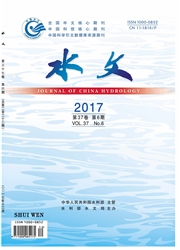

 中文摘要:
中文摘要:
以悬浮物浊度标定为研究对象,通过对不同分析方法得到的浓度结果与浊度仪之间相关性的分析,探索悬浮物浓度测量的较佳方案.根据实测数据的对比分析,发现现场抽滤法相较于自然焚烧法、室内抽滤法和沉淀烘干法,具有省时间、低费用、高效率和可靠性高的特点.主要原因为室内各类分析方法相较于现场抽滤会出现较多不确定的影响因素,包括运输存储过程中容器瓶壁的吸附作用、水样微生物的滋长以及方法本身的系统误差,如焚烧法操作过程,有机物在高温环境下挥发,致使分析处理的研究对象与观测仪器所测不同,导致产生比较大的误差.现场抽滤法不但适合在水流比较平稳的内河使用,而且在流态复杂,泥沙浓度变化较大的河口地区的泥沙浓度测量中也具有的较强实用性.
 英文摘要:
英文摘要:
With the calibration of suspended matter turbidity as the research object, the best method to measure the suspended sediment concentration was attempted to be found, through the analysis of the correlation between the concentration results obtained by different calibration methods and turbidity meter. According to the comparison and analysis of the measured data over the years, it is found that on-site sucking filtration method is time-saving, low-cost, highly efficient and more reliable, being compared with natural incineration, indoor filtration method and drying precipitation method, with the main reason that there are many factors affecting the experiment in laboratory, such as the adsorption of container wall, growth of microorganisms in water samples during transportation and storage, and the systematic error of natural incineration that the organic matter of water sample would be volatile, resulting in the research object of the data different from the observation instrument, and hence the reliability is reduced. On-site sucking filtration method is not only suitable for using in relatively stable inland river, but also be strongly practical of the estuary sediment concentration measurement where the flow pattern is complex and the change of sediment concentration is great.
 同期刊论文项目
同期刊论文项目
 同项目期刊论文
同项目期刊论文
 期刊信息
期刊信息
